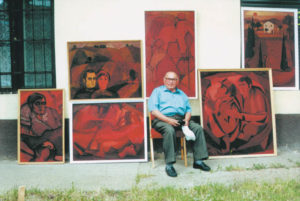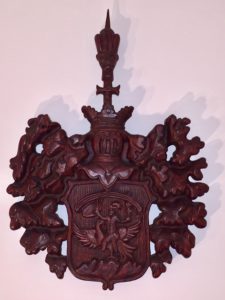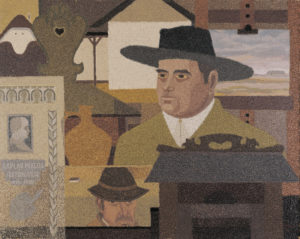
“I feel like my work is only good and true when I follow reality – when my pictures reflect the feelings of the social and human relationships of our time – when I succeed in drawing a pure picture with real emotion and content.”
Égerházi Imre
Imre Égerházi
(1925 – 2001)
Painter artist

Imre Égerházi was born in Hajdúhadház, Hungary, 1st of September 1925. He was a descendant of János Egerházi Képíró, a 17th-century fresco artist from Mezőbánd, Transylvania. In his autobiography Imre Égerházi writes that among his ancestors were painters who received conferred nobility for their services from Rákóczi Prince George the first. Their family crest depicts a knight holding a sword in his left hand and a paint brush and palette in his right. The roots of the talent, ability and instinctive interest of the young boy from Hadház extended widely in space and time from his first drawings with a box of colorful chalk on clean walls to the brush and palette.
He developed a very distinctive and well recognizable artistic world and a unique way of communicating through his paintings. This was by no means without precedents: his visual construction mode was formed by folk art and the secessionist movement, his use of color was influenced by post-impressionism, and his entire artistic approach was shaped by the Alföld art world, yet the end result truly characterizes the individual painting style of Imre Égerházi.
His works are unique not only in their technique, construction, and composition, but also in the internally driven choice of themes and their honest interpretation. His art was directly derived from and determined by his own life – including personal and social experiences , and landscape impressions.
Despite his well-articulated artistic composition, construction and abstraction, his paintings do not make an artificial or abstract impression, because the life episodes, landscapes, people, houses, objects and symbols that he chose to express, all evoke real-life sceneries. The dense, contoured and powerful shapes and figures, and finer, more intimate ambiances are all built with a very detailed, atom-like surface treatment technique, very characteristic of his paintings, applied with a uniquely interpreted pointillism. In his work, this way of constructing colors serves an artistic intention: The audience is guided by the meticulous details of the story and is not weighed down by grand statements.

The details come together in harmony across the entire canvas.
One of his series of paintings was created after he had returned from the gates of death, following a heart attack. While many have verbally described what such an experience might feel like, the way Égerházi portrays it, truly bears an authentic force, because it shows the visions of a painter. These images of the afterlife are symbolic. His desire to become a painter turned into reality, his nobleness was enforced, and wherever he is now, I believe he still is and will always remain a true painter.
Gábor Prókai
art historian
In the early 1930s, when he was a small child, his family moved to Debrecen. There, in the fifties, he attended the Free School of Fine Arts, studying under the painter József Menyhárt. He always maintained active links with his hometown, Hajdúhadház to which he donated a large part of his oeuvre in 1985, and he added to this collection for the rest of his life. Hajdúhadház provided Imre Égerházi with a creative center, which was more than a studio: it was also an important meeting place for the region’s artists.
After his death the creative center continued to operate as a memorial center, where one can view more than one hundred outstanding works from his life’s work. Imre Égerházi created an internationally unique exhibition of panel paintings in the Földi János Bilingual Primary School and Elementary Art School in Hajdúhadház. He not only painted two outstandingly important panel paintings for his former school, but also asked his European and American painter friends to do the same. The Hajdúhadház Gallery was also his brainchild and creation. He did much for the town as an artist, artistic organizer, and committed supporter of youth. In recognition of all this Hajdúhadház awarded him Freedom of the City in 1992.
His paintings can be seen in the Hungarian National Gallery, and his oeuvre is represented in the Imre Égerházi Memorial Center in Hajdúhadház, the Déri Museum in Debrecen, and in museums, public institutions and private collections in Hungary and abroad.
Imre Egerhazi talks about his panno made about the PAX in Vervins
Égerházi Imre festőművész olajfestési technikájáról beszél
Égerházi Imre festőművész monotípia festési technikájáról mesél

